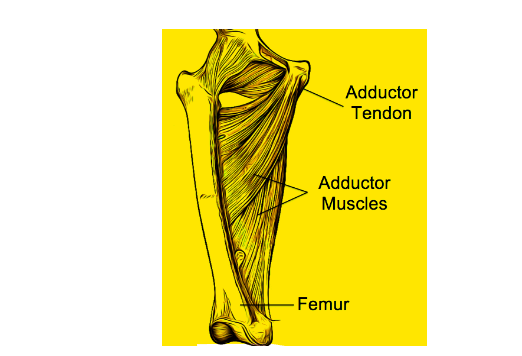Quick Overview
The adductor tendons are a group of tendons that attach the adductor muscles to the pubic bone in the pelvis. The adductor muscles are located on the inner thigh and are responsible for drawing the legs together. The adductor tendons are important for a variety of activities, including walking, running, and jumping.

Table of Contents
Anatomy of the Adductor Tendons
The Adductor Tendons are an assembly of strong fibrous connective tissue that connects the adductor muscles of the thigh to the pelvis and the femur (thigh bone). These tendons are integral in activities like walking, running, and lateral leg movements.The adductor muscles are;
- Adductor longus
- Adductor brevis
- Adductor magnus
- Gracilis
- Pectineus
Adductor Tendons Tear
An adductor tendon tear is a tear in one or more of the adductor tendons. It is a relatively rare injury, but it can occur in athletes who participate in sports that involve sudden changes in direction, such as soccer, basketball, and tennis.
Read also Supraspinatus Tendon and Triceps Tendon: Anatomy
Symptoms
Symptoms of an adductor tendons tear include:
- A sudden, sharp pain in the groin
- Difficulty walking or running
- Swelling and bruising in the groin
Treatment for an adductor tendon tear typically involves surgery to repair the tendons. In some cases, nonsurgical treatment may be possible, but it is important to see a doctor to discuss the best treatment options for your individual case.
Adductor Tendonitis
Adductor tendonitis is an inflammation of one or more of the adductor tendons. It is a more common injury than an adductor tendon tear. Adductor tendonitis can be caused by overuse of the adductor muscles, such as from running or jumping. It can also be caused by a direct blow to the groin.
Cause
Adductor tendonitis is most commonly caused by overuse of the adductor muscles. This can occur from activities such as running, jumping, and hill climbing. Other possible causes of adductor tendonitis include:
- Tightness in the adductor muscles or hamstrings
- Muscle imbalance in the legs
- Wearing shoes that do not fit properly
- Having a history of adductor tendonitis
- Being over the age of 40
Signs and Symptoms
The most common symptom of adductor tendonitis is pain in the groin, just below the pubic bone. The pain is typically worse during activity and may improve with rest. Other symptoms of adductor tendonitis include:
- Swelling and tenderness in the groin
- Difficulty walking or running
- Crepitus (a popping or grinding sensation) in the groin
- Stiffness in the groin
Diagnosis
Adductor tendonitis is typically diagnosed based on a physical examination and medical history. Imaging tests, such as an ultrasound or MRI, may be ordered to confirm the diagnosis and assess the severity of the injury.
Treatment
Treatment for adductor tendonitis is typically conservative and includes rest, ice, compression, and elevation (RICE). Physical therapy may also be recommended to help strengthen the adductor muscles and reduce inflammation. In some cases, nonsteroidal anti-inflammatory drugs (NSAIDs) or corticosteroid injections may be prescribed to help reduce pain and inflammation.
If conservative treatment is not effective, surgery may be considered to remove the inflamed portion of the adductor tendons. However, surgery is rarely necessary for adductor tendonitis.
Prevention
The best way to prevent adductor tendonitis is to avoid overuse of the adductor muscles. This can be done by gradually increasing the intensity and duration of your workouts, and by wearing shoes that fit properly. Other things you can do to help prevent adductor tendonitis include:
- Stretching your adductor muscles regularly
- Warming up before exercise and cooling down afterwards
- Maintaining a healthy weight
Questions
Q: How long does adductor tendonitis take to heal?
The healing time for adductor tendonitis varies depending on the severity of the injury and the individual’s healing process. Most people recover within 6 weeks to 3 months, but some people may take longer.
Q: What are the risks of adductor tendonitis surgery?
The risks of adductor tendonitis surgery include infection, bleeding, nerve damage, and wound healing problems. In rare cases, the tendon may rupture again after surgery.
Q: What can I do to prevent adductor tendonitis?
To help prevent adductor tendonitis, you can:
1- Gradually increase the intensity and duration of your workouts.
2- Wear shoes that fit properly and provide good support.
3- Stretch your adductor muscles regularly.
4- Warm up before exercise and cool down afterwards.
5- Maintain a healthy weight.
Q: What is the best way to treat adductor tendonitis?
The best way to treat adductor tendonitis depends on the severity of the injury. In most cases, treatment includes rest, ice, compression, and elevation (RICE). Physical therapy may also be recommended to help strengthen the adductor muscles and reduce inflammation. In some cases, nonsteroidal anti-inflammatory drugs (NSAIDs) or corticosteroid injections may be prescribed to help reduce pain and inflammation.
Q: What are the long-term complications of adductor tendonitis?
Long-term complications of adductor tendonitis include:
1- Chronic pain
2- Weakness in the adductor muscles
3- Stiffness in the groin
4- Recurrence of tendonitis
